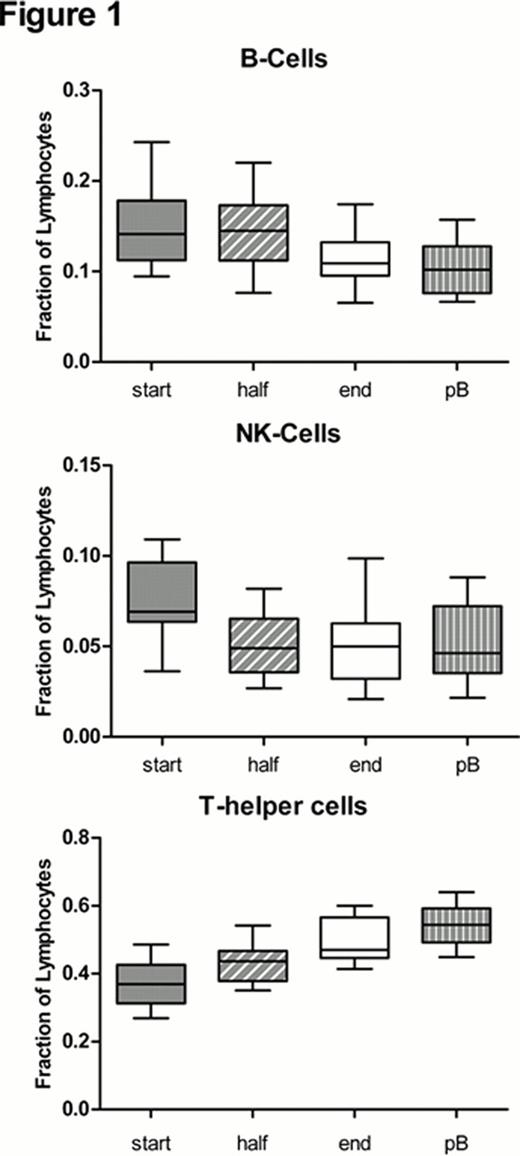Abstract
Abstract 1915
Bone marrow (BM) has been associated with a decreased rate of Graft-versus-Host-Disease (GvHD) when compared to peripheral blood stem cells (PBSC) in the context of allogeneic stem cell transplantation (allo-SCT). It has been reasoned that this may relate in part to the differential quantitative and qualitative immunologic composition of both stem cell sources. It has, for example, been noted that BM contains a higher percentage of CD8+ T-cells, natural killer (NK) cells and recently also more regulatory T-cells than PBSC. It is further known that the total nucleated cell concentration (TNC) correlates negatively with the BM harvest volume, which could argue for an increasing dilution of the transplant with peripheral blood (pB) during the BM harvest. How this impacts on the different immunological compartments and how the BM at different time points of the harvest procedure compares to PBSC products has not been determined yet.
During routine BM harvest procedures (n = 24) we subjected a part of the aspirate drawn at the beginning, after withdrawing half of the prescribed volume and at the end of the harvest procedure to detailed immunophenotyping using multicolor flowcytometry including intracellular staining for FoxP3 and IL17. The PBSC products of an age matched group (n = 20) were analyzed in parallel with the same flowcytometry protocols and used as a comparison.
During the BM harvest the median TNC dropped rapidly from 53.2 Gpt/l in the beginning to 17.0 Gpt/l after half the volume had been collected and finally reached 6.2 Gpt/l at the end of the procedure. As expected, the first BM specimen contained a higher concentration of NK- (6.7 vs. 4.6 %, p = 0.001) and B-cells (14.1 vs. 10.2 %, p < 0.001) but less T-helper-(Th)-cells (36.0 vs. 53.7 %, p < 0.001) than pB. After collection half of the prescribed volume the NK-cell concentration had already dropped to 4.5 %, which was not significantly different from pB (p = 0.412) anymore. The B-cell concentration, however, remained at levels comparable to the first specimen (14.5 %) and significantly differed from pB (p < 0.001). The last BM specimen drawn still had a higher B-cell concentration than pB (10.9 vs. 10.2 %), although this was not statistically significant (p = 0.265). Th-cells demonstrated a steady increase in concentration during the harvest with a median concentration of 43.4 and 47.0 % in the middle and at the end of the procedure. Both the halfway value and the end of harvest concentration were significantly different from pB (p < 0.001 and p = 0.004, respectively). An overview on the NK-, B- and Th-cell-concentrations at the different time points analyzed can be found in Figure 1.
Within the Th compartment we were unable to see a clear trend for Treg which had a concentration of 7.6 % in the beginning, 7.0% halfway and 7.1 % after all BM had been collected. None of these concentrations was significantly different from that found in pB (7.6 %). The same applied to Th17 cells which made up 0.51 % of Th in the beginning, 0.59 % in the middle and 0.50 % at the end of the procedure and 0.84 % in the pB. Moreover there was no significant difference between the first BM specimen and PBSC products with respect to Treg (7.6 vs. 6.7 %, p = 0.181) or Th17 (0.51 vs. 0.61 %, p = 0.100). In contrast, the NK- and Th-cell concentration in PBSC products was significantly higher than in the first BM specimen (NK: 10.7 % vs. 6.7 %, p =0.005; Th: 40.3 % vs. 36.0 %, p =0.038).
We conclude that the composition of immune cells within the BM changes significantly during the harvest procedure probably due to an increasing dilution with peripheral blood. These changes variably affect different compartments and may have an impact on post-transplant immunological function and complications. Therefore BM harvest volumes may need to be considered when comparing BM and PBSC with respect to clinical outcomes. In contrast to previous reports, we found no indication that BM, no matter at which time point analyzed, contained a higher concentration of Treg when compared to PBSC.
No relevant conflicts of interest to declare.
Author notes
Asterisk with author names denotes non-ASH members.


